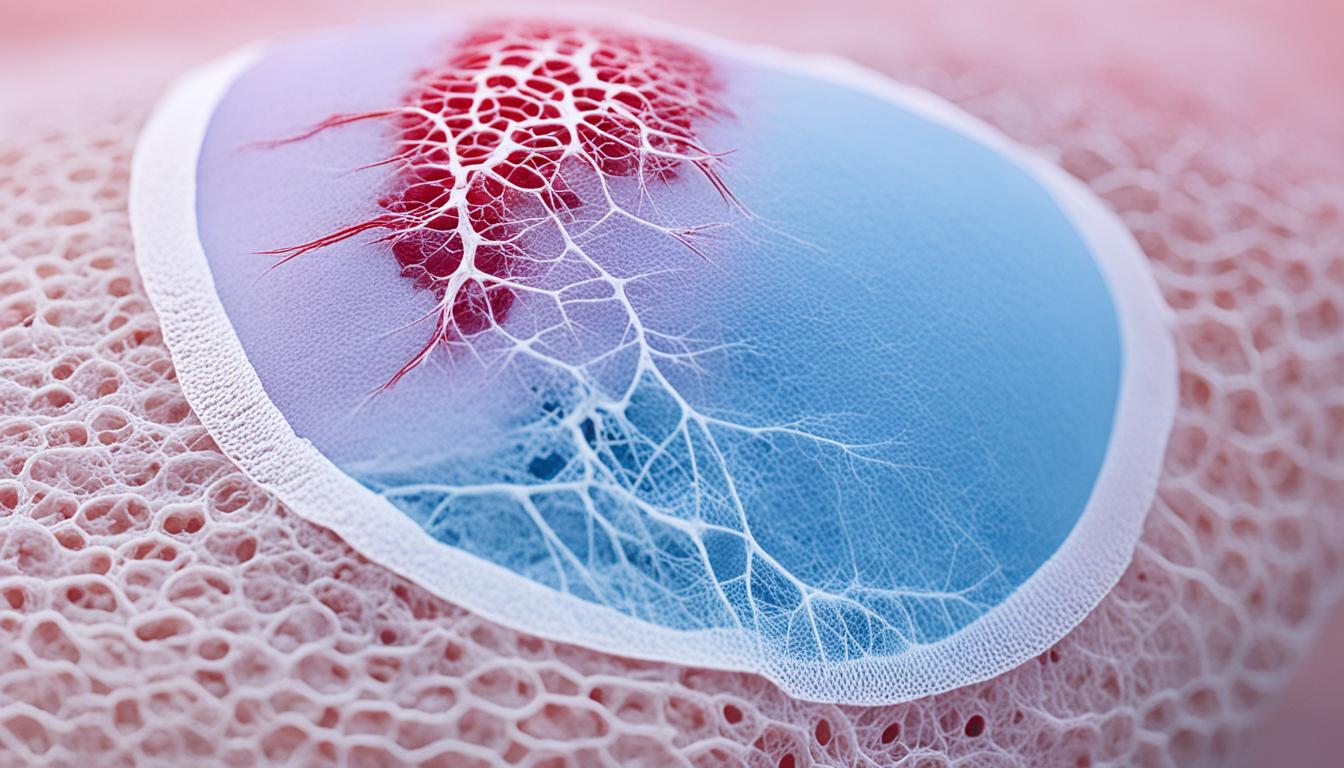Calciphylaxis is a rare but serious skin disease mostly seen in those with late-stage kidney failure. It causes the skin’s blood vessels to get blocked, leading to severe pain and wounds. Though scientists don’t fully know why people get this disease, they think blood clotting issues might play a big role.
As of now, there is no surefire way to treat calciphylaxis. But there’s hope in the form of stem cell therapy. By using stem cells from the amniotic membrane, this approach has helped with clotting problems, wound healing, and pain relief in some patients. However, more studies are needed to confirm these benefits and understand how stem cells work against calciphylaxis.
Key Takeaways:
- Calciphylaxis is a severe cutaneous vascular disease primarily affecting patients with end-stage kidney disease.
- Common symptoms of calciphylaxis include intolerable pains and non-healing skin wounds.
- The exact causes of calciphylaxis remain unclear, but thrombophilias and hypercoagulable conditions have been identified as prevalent.
- Stem cell therapy, particularly using stem cells derived from human amnion, is a potential treatment option for calciphylaxis.
- Further research is needed to understand the mechanisms and effectiveness of stem cell therapy in calciphylaxis management.
Symptoms of Calciphylaxis
Calciphylaxis is a harsh disease with many symptoms that can change a person’s life. Knowing these signs early helps doctors start treatment fast. The main signs are:
- Severe pain: People with calciphylaxis feel a lot of pain, calling it unbearable. This pain can stay or go and gets worse when you move or touch the area.
- Non-healing skin wounds: Open wounds or ulcers that don’t heal are a sign. They can grow deep, close slowly, and easily get infected.
- Purpura: This is when the skin shows purple or red spots from under-skin bleeding. Seeing these spots could mean calciphylaxis.
- Livedo reticularis: It shows as a net-like pattern on the skin, caused by blood flow problems. It looks reddish or bluish and can be seen in calciphylaxis patients.
- Necrotic ulcerations: The worst cases can have deep, black ulcers from dead tissue. These ulcers hurt, can get infected, and heal slowly.
These skin issues mainly happen on the legs, buttocks, and thighs. If you see these signs in yourself or someone you know, it’s important to see a doctor right away. This helps with getting the right care and starting treatment on time.
Causes and Risk Factors of Calciphylaxis
Calciphylaxis is a rare, serious disease. The causes are not fully known. Yet, some risks have been shown to be linked, like kidney issues.
Problems like end-stage kidney disease can often lead to calciphylaxis. But obesity and diabetes can also increase the risk. These risk factors show us how complex this disease is.
1. Hyperparathyroidism: When the parathyroid glands work too hard, it can lead to more of a certain hormone being made. This can raise the chance of getting calciphylaxis.
2. Hypercoagulable states: Some illnesses make blood clot more easily. If you have these, your risk of calciphylaxis might go up. Illnesses like antiphospholipid syndrome and certain genetic mutations can make blood vessels clog more.
3. Obesity: Being very overweight (obese) can also increase your risk. Fats in the body might cause more inflammation, which can harden blood vessels.
4. Diabetes: Diabetes can worsen your chances of getting calciphylaxis. This is especially true if your diabetes is not controlled well. Problems with blood vessels due to diabetes could be a key factor.
5. Medications: Taking certain drugs might up your risk level. An example is warfarin, often used to thin blood. In some people, it has been tied to calciphylaxis.
Remember, having these risk factors doesn’t mean you will get calciphylaxis. But they do make it more likely.
It’s important to know the causes and risks of calciphylaxis. This helps catch it early and find better ways to treat it. Doctors and nurses use this info to plan care that can really help patients.
Management of Calciphylaxis and Potential Role of Stem Cell Therapy
Treating calciphylaxis needs a detailed plan. We focus on caring for wounds, handling pain, and dealing with the root problems. There are no set rules for treating calciphylaxis, but doctors have looked into a few methods. These ways include surgery to remove dead tissue, using oxygen therapy under pressure, giving drugs like sodium thiosulfate, and blood thinners. The goal of these treatments is to cut down symptoms and help patients get better.
Stem cell therapy is becoming an exciting option in calciphylaxis care. Using stem cells from the human amnion area, known as mesenchymal stem cells, has shown good signs. These cells can help with blood clotting issues, speed up healing of wounds, and lower pain. Yet, we need more studies and tests to make sure this therapy is both effective and safe for patients.
Doctors are looking at how stem cell therapy might change the game for calciphylaxis. By using stem cells that can regenerate, we might improve treating this tough disease. The progress in using stem cells could make life better for those with calciphylaxis. It could give them new hope and make the harsh symptoms easier to handle.

